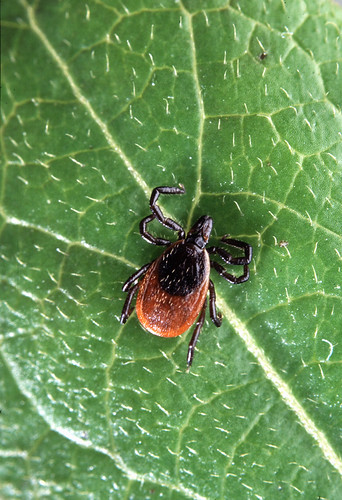
As we kickoff the traditional start to the summer and head outdoors, remember to apply that sunscreen. Oh, and watch for ticks. According to Andrew Li, an Agricultural Research Service (ARS) entomologist who is leading a new deer tick control program, they’re out in force, too. Experts predict 2017 will see the highest number in years of these sesame-seed-size parasites—also known as “blacklegged ticks”—that spread the bacteria that cause Lyme disease.
Several factors have contributed to the upsurge. A bumper crop of red oak acorn last fall and an overall warmer-than-usual winter in the Midwest and the East added up to a population explosion of white-footed mice, which typically provide deer tick larvae with their first blood meal. Along with this blood, ticks can get the Lyme disease-causing bacteria Borrelia burgdorferi (B. burgdorferi). The warmer winter also kept some of the tick population from dying during what is usually their dormant period.
Upon the arrival of spring, ticks have become active again, looking for their next blood meals, and it doesn’t really matter if it comes from a deer, dog or human. Ticks don’t discriminate. White-tailed deer are just the most common medium- to large-size mammal to walk through the tall grass and brush where deer ticks wait to hop aboard the buffet.
Li, who coordinates the ARS five-year Area-Wide Integrated Tick Management Project, is comparing several control methods in wooded areas and bordering residential suburban neighborhoods. He hopes to reduce the percentage of both white-footed mice and white-tailed deer that are carrying ticks or at least ticks infected with B. burgdorferi.
Control methods include rodent bait boxes, ARS-patented “4-poster” deer treatment feeders, and a bioinsecticide spray, all based on the principles of integrated pest management (IPM)—using the least amount of pesticides possible while still getting the job done. Both the 4-poster feeder and the mouse bait box are designed to lure in deer and mice, respectively, so they may brush up against a tick-killing pesticide.
One of the project’s unique features is that before Li decides where to put the 4-posters, his team is fitting a number of deer with GPS collars to track the paths of bucks and does between parklands and residential areas. This will bring scientific precision to where the 4-posters are placed—something that has not been done before.
While there is some information about deer movement patterns in suburban landscapes, the exact relationship between white-tailed deer travels and tick distribution isn’t well understood.
Ultimately, Li wants to create an IPM-based control strategy that can easily be used by neighborhood associations, public health agencies especially at the municipal and county levels, and even by individual homeowners.

